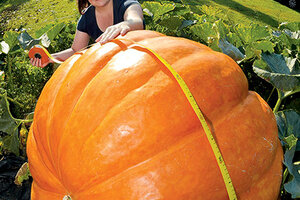Now’s the time to prepare to grow a monster
Enormous pumpkins need lots of good soil and attention.

First-time grower Silvia Manteuffel of Germany grew a 570-pounder.
Patrick Pleul/AP
If you want to display the largest jack-o’-lantern on your block this year, you may find that a 50-pounder isn’t big enough. Backyard gardeners are routinely growing pumpkins that weigh from 500 pounds to more than 2,000 pounds – and you could, too.
It isn’t difficult for anyone who’s grown good vegetables to raise a humongous pumpkin. It just takes dedication and paying attention to the plant’s needs: good soil, plenty of water and fertilizer, plus no competition from other pumpkins on the same vine.
The first step is to choose a variety of seed known to grow giant pumpkins. Atlantic Giant is one that’s popular, but read catalog descriptions for others. Then, as all gardeners know, good soil is the key to growing success. Get a head start now by choosing a spot about 25 feet by 25 feet that’s in full sun and has well-drained soil. Mix in plenty of compost or other organic matter (shredded leaves, seaweed, straw or hay with no seeds) and – this is important – as much as four inches of horse or cow manure. Because pumpkins are shallow-rooted, it’s fine to do this by hand; no tiller needed.
In spring, have the soil tested by the local extension service to see if it needs lime and what kind of nutrients may be lacking. Slightly acidic soil (pH 6.5 to 6.8) is ideal. Dig in required fertilizer. A few weeks after your average last frost, you’ll be ready to plant.
In areas that are still chilly in April and May, start seeds (one per four-inch peat pot) indoors. After the first two true leaves have formed, set the plants out in the garden (plant each one on a slightly elevated hill of soil about the height of a baseball pitcher’s mound). Protect young plants from inclement weather with a burlap windbreak or commercial frost-protecting row cover. To help the soil warm up, gardeners in cold climates can place black plastic sheeting over the soil early in the season. Later, spread a mulch of organic material to deter weeds.
Pumpkins are about 90 percent water, so keep the soil moist during the growing season. This may require 20 gallons of water twice a week if rainfall is insufficient. (Trickle irrigation makes this easy and also keeps water off the vine and leaves to avoid mildew.) Again, you want the soil to stay evenly moist: Alternating between wet and dry soil causes pumpkins to crack.
Starting in early July, some growers use liquid fertilizer every other week when watering. But also be prepared to apply a balanced granular fertilizer (nitrogen, phosphorus, potash) throughout the growing season.
In early to midsummer, depending on your climate, the vine will begin to produce flowers. The difference between the male and female blooms is that the females – the ones that will produce pumpkins – have tiny pumpkins at their base. Let the bees pollinate them or do it by hand, if you prefer. Once your vine has several pumpkins larger than softballs, remove all but the strongest or fastest growing. That allows the plant to devote all its energy to the one pumpkin that remains, which will naturally grow bigger and bigger. As the pumpkin begins to rest on the ground, place sand underneath to keep it dry.
All summer, weed by hand, watch out for insects, and remove any other pumpkins that try to form. Many award-winning growers cover the potential giant pumpkin, starting about midsummer, with a sheet or a tarp arranged a few feet above it. This protects it from too much sun and encourages more growth. You can pinch off the end of the vine in August to divert more growth to the fruit.
In fall, protect the pumpkin from frost. Harvest when the skin is hard and the vine has begun to die back. Most giant pumpkins aren’t the right shape for jack-o’-lanterns, and many are hollow. So you may not end up with a traditional display or many pies for Thanksgiving. But if you’re a typical first-time giant pumpkin grower, you’ll be out in the garden next year, planting seeds and dreaming of an even more massive one, maybe even a world record.

